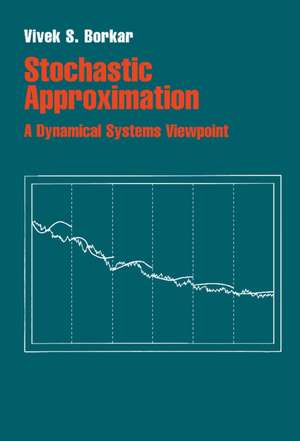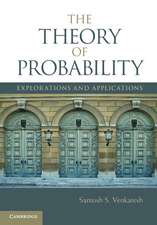Stochastic Approximation: A Dynamical Systems Viewpoint
Autor Vivek S. Borkaren Limba Engleză Hardback – 31 aug 2008
| Toate formatele și edițiile | Preț | Express |
|---|---|---|
| Hardback (2) | 443.43 lei 6-8 săpt. | |
| Springer Nature Singapore – feb 2024 | 649.87 lei 3-5 săpt. | |
| Cambridge University Press – 31 aug 2008 | 443.43 lei 6-8 săpt. |
Preț: 443.43 lei
Preț vechi: 498.24 lei
-11% Nou
Puncte Express: 665
Preț estimativ în valută:
84.85€ • 90.73$ • 70.75£
84.85€ • 90.73$ • 70.75£
Carte tipărită la comandă
Livrare economică 18 aprilie-02 mai
Preluare comenzi: 021 569.72.76
Specificații
ISBN-13: 9780521515924
ISBN-10: 0521515920
Pagini: 176
Dimensiuni: 157 x 233 x 17 mm
Greutate: 0.39 kg
Ediția:1
Editura: Cambridge University Press
Colecția Cambridge University Press
Locul publicării:Cambridge, United Kingdom
ISBN-10: 0521515920
Pagini: 176
Dimensiuni: 157 x 233 x 17 mm
Greutate: 0.39 kg
Ediția:1
Editura: Cambridge University Press
Colecția Cambridge University Press
Locul publicării:Cambridge, United Kingdom
Cuprins
Preface; 1. Introduction; 2. Basic convergence analysis; 3. Stability criteria; 4. Lock-in probability; 5. Stochastic recursive inclusions; 6. Multiple timescales; 7. Asynchronous schemes; 8. A limit theorem for fluctuations; 9. Constant stepsize algorithms; 10. Applications; 11. Appendices; References; Index.
Recenzii
'I highly recommend [this book] to all readers interested in the theory of recursive algorithms and its applications in practice.' Mathematical Reviews
'This simple compact toolkit for designing and analyzing stochastic approximation algorithms requires only basic literacy in probability and differential equations … Ideal for graduate students, researchers and practitioners in electrical engineering and computer science, especially those working in control, communications, signal processing and machine learning, this book is also relevant to economics, probability and statistics.' L'Enseignement Mathématique
'This simple compact toolkit for designing and analyzing stochastic approximation algorithms requires only basic literacy in probability and differential equations … Ideal for graduate students, researchers and practitioners in electrical engineering and computer science, especially those working in control, communications, signal processing and machine learning, this book is also relevant to economics, probability and statistics.' L'Enseignement Mathématique
Notă biografică
Descriere
Simple, compact toolkit for designing and analyzing algorithms, with concrete examples from control and communications engineering, artificial intelligence, economic modelling.
Textul de pe ultima copertă
This book serves as an advanced text for a graduate course on stochastic algorithms for the students of probability and statistics, engineering, economics and machine learning. This second edition gives a comprehensive treatment of stochastic approximation algorithms based on the ordinary differential equation (ODE) approach which analyses the algorithm in terms of a limiting ODE. It has a streamlined treatment of the classical convergence analysis and includes several recent developments such as concentration bounds, avoidance of traps, stability tests, distributed and asynchronous schemes, multiple time scales, general noise models, etc., and a category-wise exposition of many important applications. It is also a useful reference for researchers and practitioners in the field.
Caracteristici
Presents a comprehensive view of the ODE-based approach for the analysis of stochastic approximation algorithms Discusses important themes on stability tests, concentration bounds, and avoidance of traps Covers very recent developments with copious pointers to related literature









